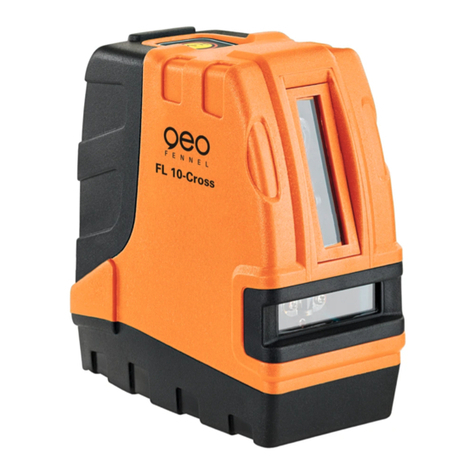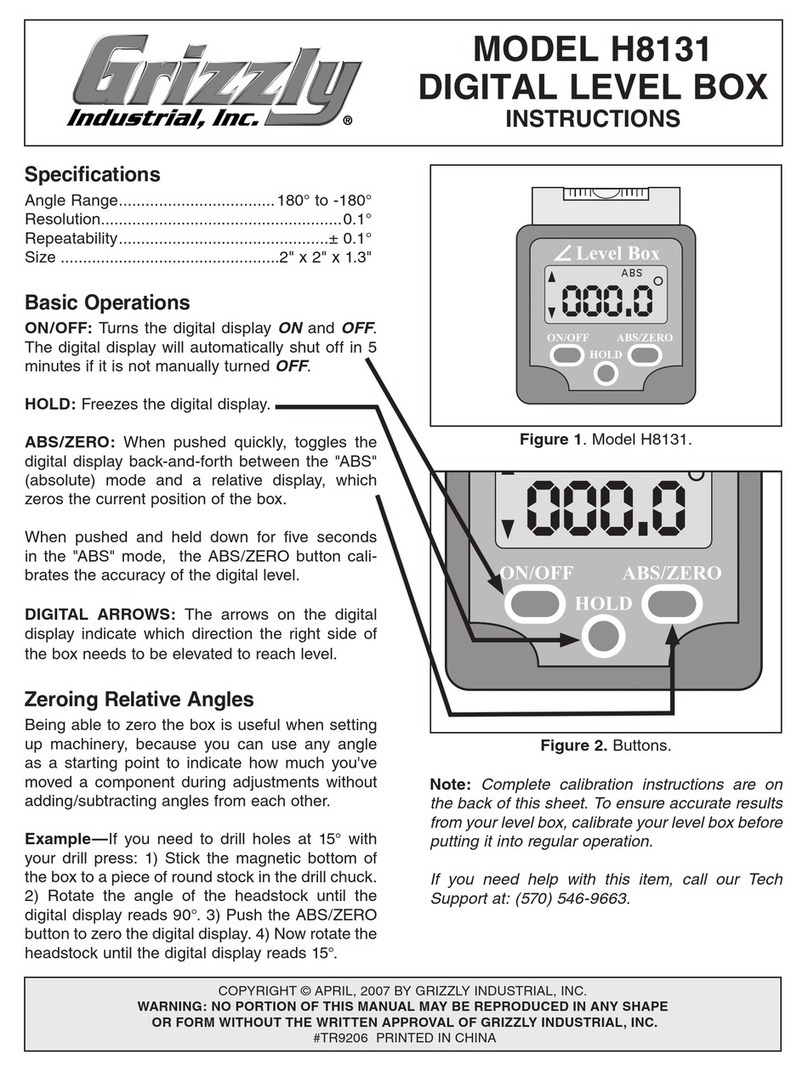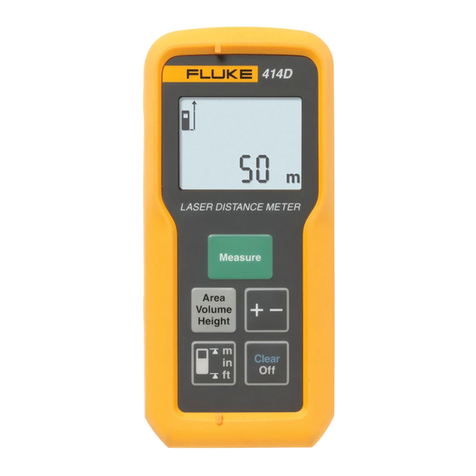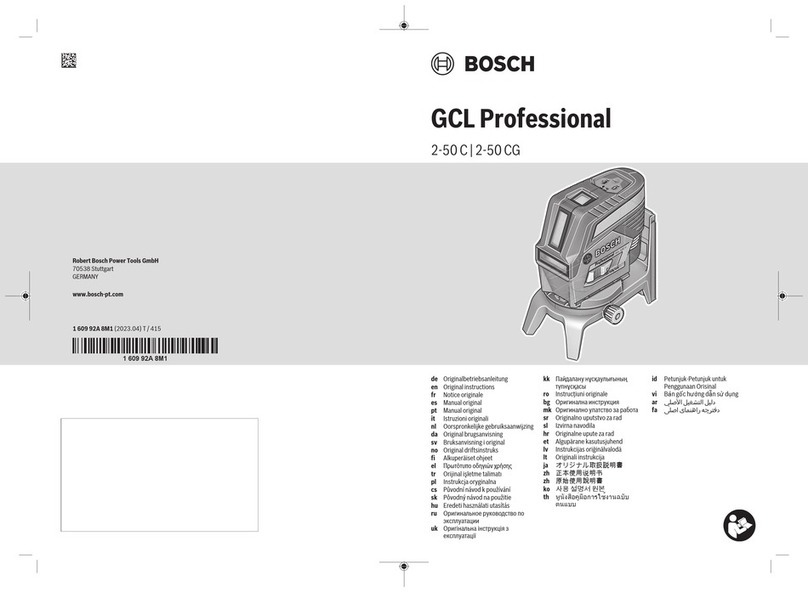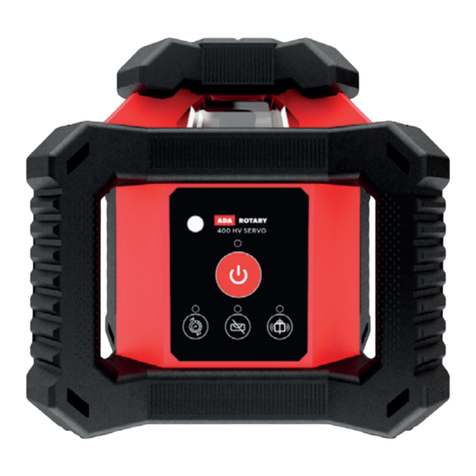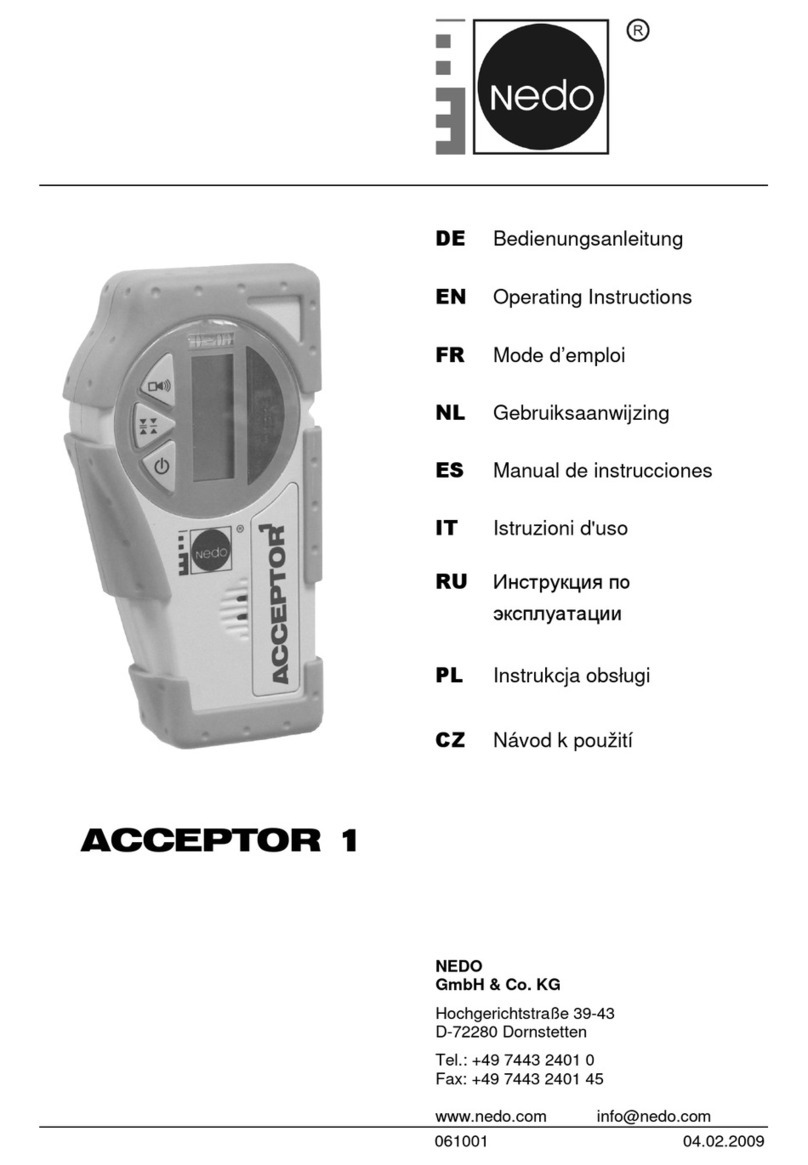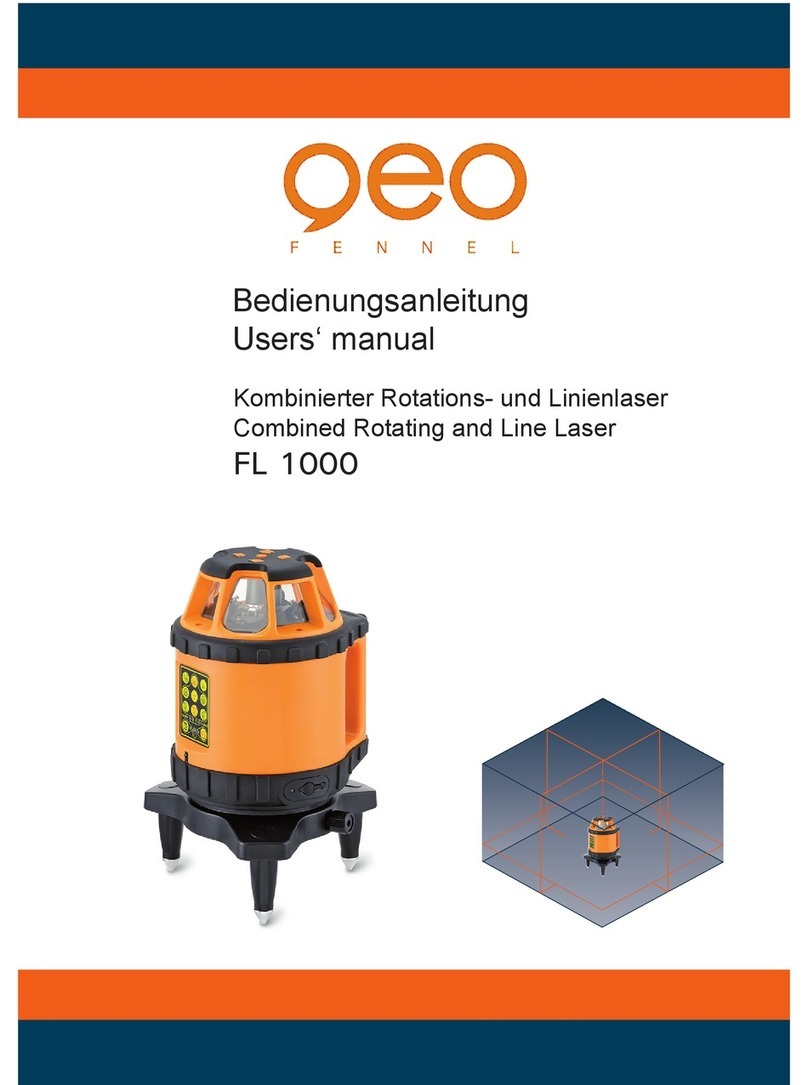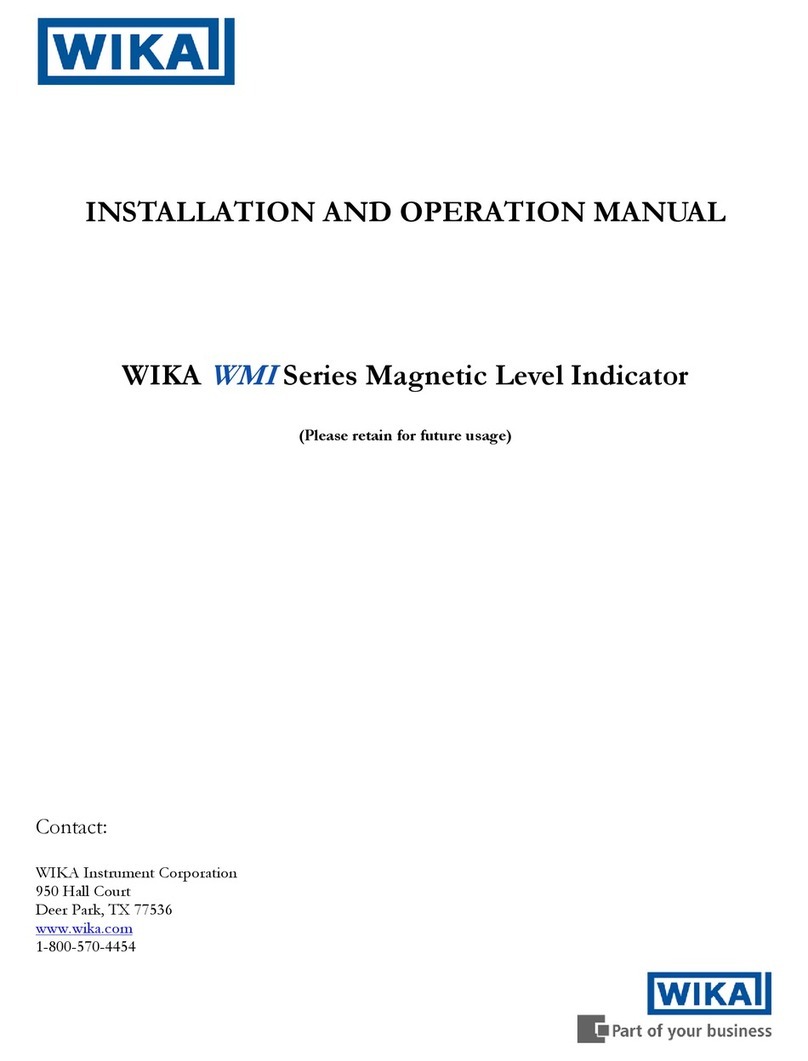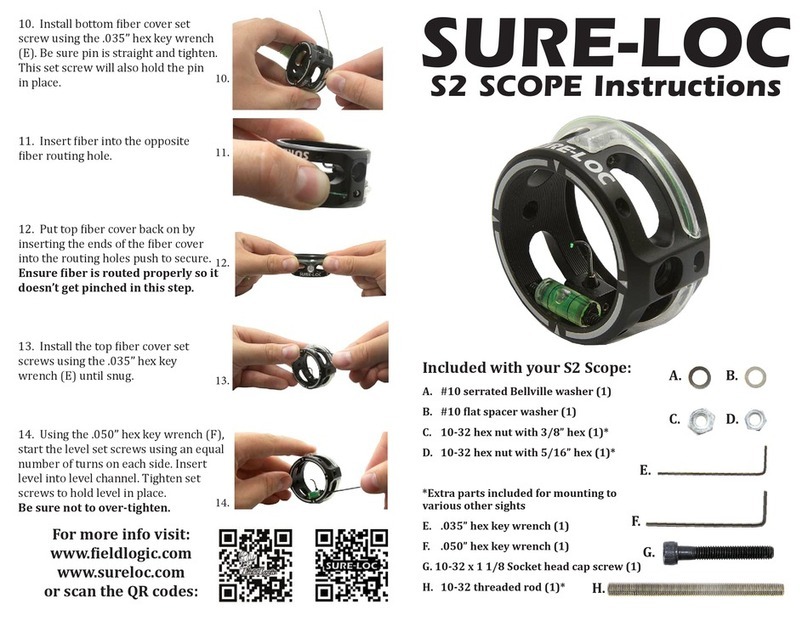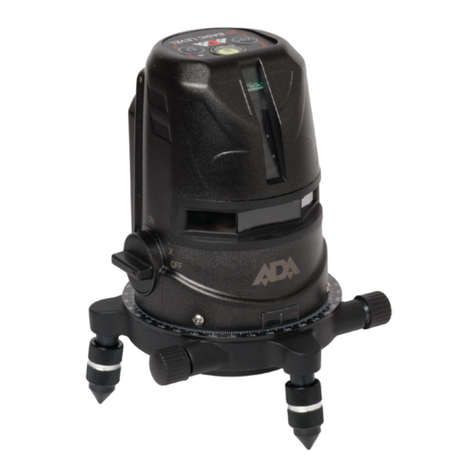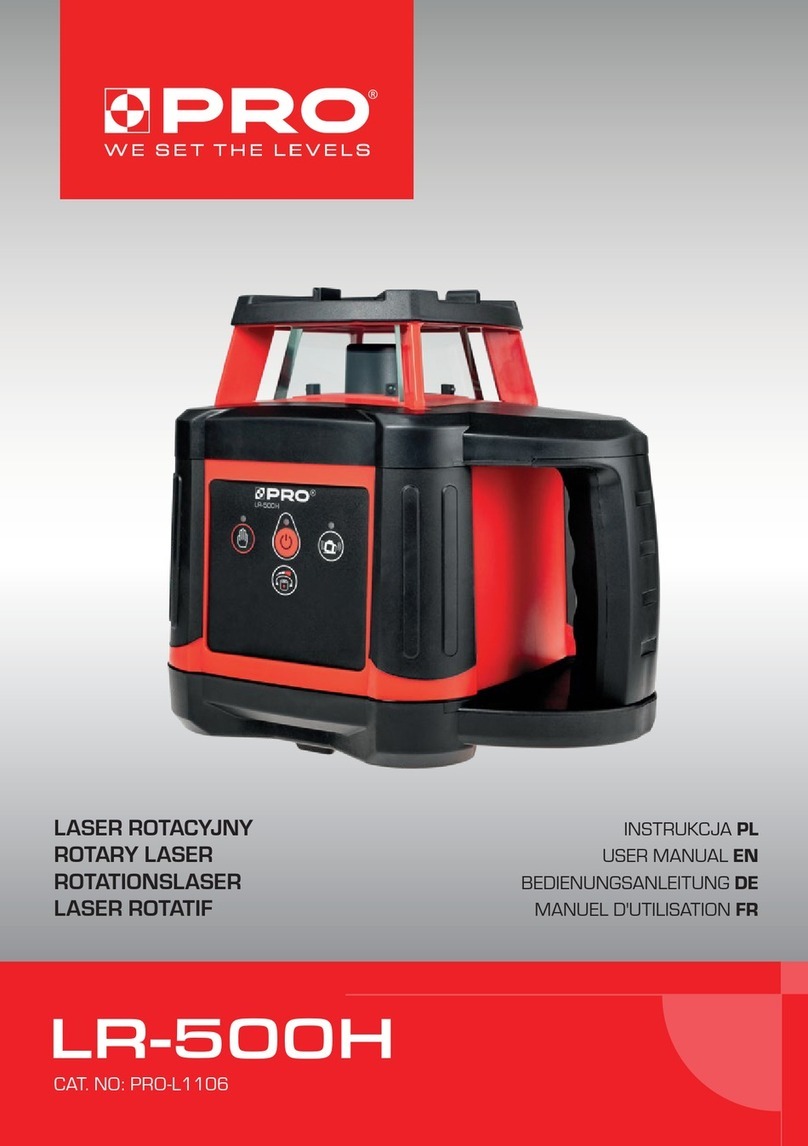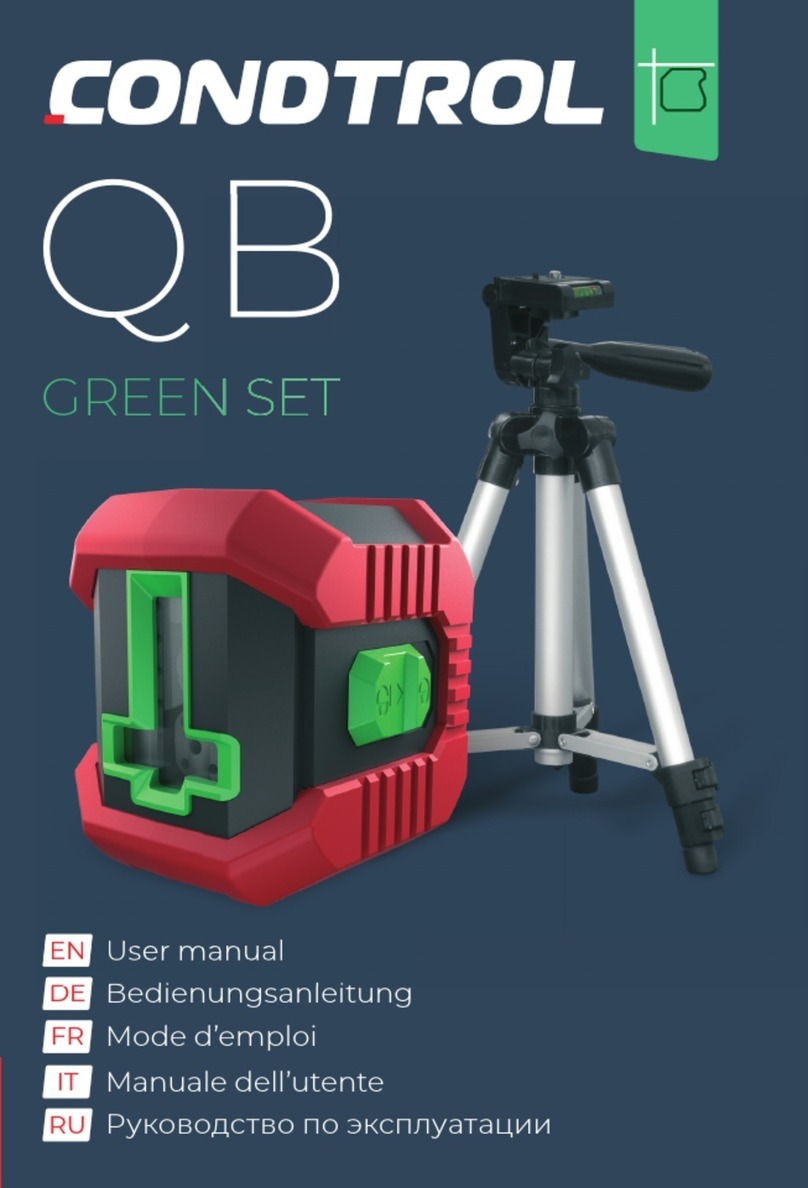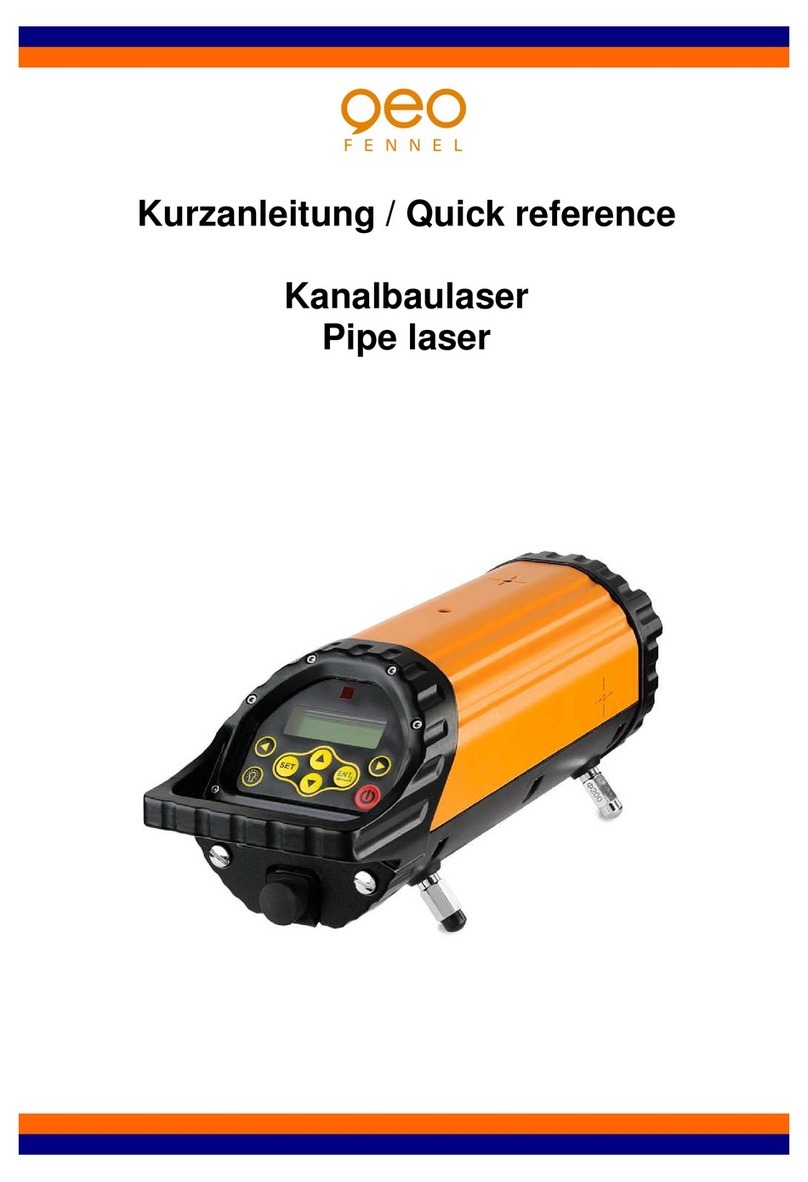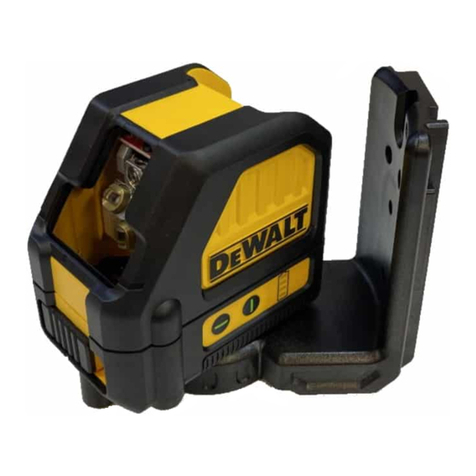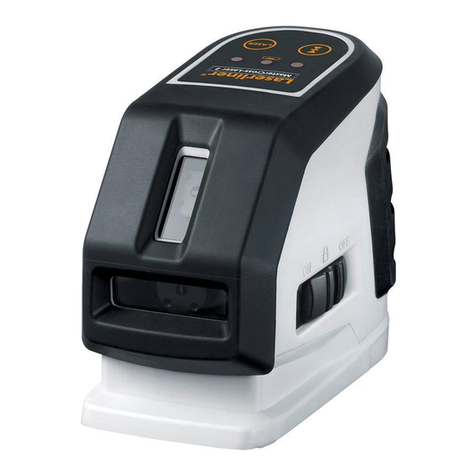TOUGHBUILT TB-H2-LL-M30-L2 Assembly instructions

TB-H2-LL-M30-L2
30mCROSS-LINE LASER LEVEL KIT
OPERATING / SAFETY
INSTRUCTIONS
DE LASERNIVELLIER MIT KREUZLINIENLASER FÜR 30m
BETRIEBS- / SICHERHEITSANWEISUNGEN
FR NIVEAU LASER EN CROIX AUTO-NIVELANT
À FAISCEAU VERT DE 30m
CONSIGNES D'UTILISATION ET DE SÉCURITÉ
ES NIVEL LÁSER DE LÍNEA CRUZADA AUTONIVELANTE
DE HAZ VERDE DE 30m
INSTRUCCIONES DE USO/SEGURIDAD

2 3
LANGUAGES
English 3
Deutsch 29
Français 55
Español 81
IMPORTANT! Read all safety warnings and instructions before using.
WICHTIG! Lesen Sie vor der Verwendung alle Sicherheitshinweise
und Anweisungen.
IMPORTANT! Lisez tous les avertissements relatifs à la sécurité et
toutes les instructions avant d'utiliser l'appareil.
¡IMPORTANTE! Lea todas las advertencias de seguridad
e instrucciones antes de usar.
30mCROSS-LINE LASER LEVEL KIT
OPERATING / SAFETY
INSTRUCTIONS
ENGLISH

4 5
Before using this product, review and familiarise yourself with the contents of this manual.
The specifications and general appearance of the instrument are subject to change
without notice and without obligation by ToughBuilt®Industries, Inc. and may differ
from those appearing in this manual.
TABLE OF CONTENTS
1. SAFETY AND PRECAUTIONS 6
2. PRODUCT INFORMATION
Intended Use 10
What is Included 10
Specifications 11
3. HOW TO OPERATE
Installing the Batteries 12
Powering ON/OFF 13
Setting the Operating Function 14
QuickSet®Rotating Mount
and Ceiling Bracket 14
Using QuickSet®Rotating Mount 15
Using Ceiling Bracket 17
Working with the Laser Target Plate 17
4. ACCURACY CHECK 18
5. TROUBLESHOOTING 25
6. CARE AND MAINTENANCE
Cleaning 26
Storage 26
7. DISPOSAL 27
8. GUARANTEE AND REGISTRATION
Guarantee Information 28
Online Registration 28
1 Laser Beam Window 6 H/V Laser Beam Selector Button 11 Keyhole Slot
2 Pendulum Switch 7 Battery Compartment Latch 12 QuickSet®Rails
3 Battery Charge Level Indicator 8 Battery Compartment Cover 13 Height-Adjustment Knob
4 Pendulum Locked Indicator 9 Threaded Mount 14 Laser Target Plate
5 Power ON/OFF Button 10 QuickSet®Mount
3
1
4
6
5
2
8
7
9
10
11
12
13 14

6 7
The label may include the following symbols:
Battery Safety Instructions
WARNING! Batteries can explode or leak and cause injury or fire if installed backward,
disassembled, or exposed to water, fire, or high temperature. To reduce this risk:
ALWAYS follow the instructions and warnings on the battery label and packaging.
ALWAYS keep batteries out of reach of children.
DO NOT charge alkaline batteries.
ALWAYS insert batteries correctly noting the polarity (+ and –) marked on the battery
and the equipment.
1. SAFETY AND PRECAUTIONS
SAVE ALL WARNINGS AND INSTRUCTIONS FOR FUTURE REFERENCE
General Safety Rules
This instrument is a sensitive, precision instrument and should be treated as such.
WARNING! Read and understand all instructions. Failure to follow all instructions below
may result in exposure to hazardous radiation, electrical shock, fire, and/or serious injury.
WARNING! THIS DEVICE IS A CLASS 2 LASER PRODUCT IN ACCORDANCE WITH
IEC 60825-1:2014 AND EMITS VISIBLE LASER BEAMS.
DO NOT allow persons who are unfamiliar with this device, the device operating manual,
and these safety instructions to operate this device.
DO NOT stare directly into a beam or use any optical instruments to view the laser beam.
Serious eye injury could result.
If a laser beam strikes your eyes, immediately close your eyes, and turn away.
DO NOT direct it at others. Serious eye injury could result.
DO NOT set the laser beam at eye level.
CAUTION! Eye exposure to laser beam increases for people who are wearing prescription
glasses/lenses.
DO NOT use this laser device for anything other than its intended purpose.
DO NOT disassemble or modify the device. Tampering with this device may result in
hazardous laser radiation exposure and will automatically void all guarantees.
DO NOT leave the device turned on when unattended. Always turn off the device when it
is not in use.
DO NOT operate the laser device around children nor allow children to operate the laser device.
ALWAYS position the laser device securely. Damage to the laser device and/or injury
to the user could result if the laser device falls.
ALWAYS use ToughBuilt accessories specifically designed for this product.
The use of any other accessories may create a risk of injury.
The following label is on your laser device:
WARNING! DO NOT remove or deface
warning labels.
Symbol Meaning Symbol Meaning
V Volts Read the instruction manual
mW Milliwatts Warning / Caution
Laser Warning Risk of eye injury. Wear ANSI-approved
safety goggles with side shields.
nm Wavelength in Nanometers DO NOT Stare Into Beam.
Class 2 Laser Product Laser Radiation.
Safety Symbols
The definitions below describe the level of severity for each signal word.
Please read the manual and pay attention to these symbols.
This is the safety alert symbol. It is used to alert you to potential personal injury hazards.
Obey all safety messages that follow this symbol to avoid possible injury or death.
DANGER DANGER: Indicates an imminently hazardous situation which, if not avoided,
will result in serious injury or death.
WARNING WARNING: Indicates a potentially hazardous situation which, if not avoided,
could result in serious injury or death.
CAUTION CAUTION: Indicates a potentially hazardous situation which, if not avoided,
may result in minor or moderate injury.
IMPORTANT! Indicates a practice not related to personal injury which, if not avoided,
may result in malfunction or property damage.

8 9
Use safety equipment. Always wear ANSI-approved safety goggles. Safety equipment
such as dust masks, non-skid safety shoes, hard hats, or hearing protection used for
appropriate conditions will reduce the risk of personal injuries.
FCC Cautions
This equipment has been tested and found to comply with the limits for a Class B digital
device, pursuant to Part 15 of the FCC Rules. These limits are designed to provide
reasonable protection against harmful interference in a residential installation. This
equipment generates, uses and can radiate radio frequency energy and, if not installed
and used in accordance with the instructions, may cause harmful interference to radio
communications.
However, there is no guarantee that interference will not occur in a particular installation.
If this equipment does cause harmful interference to radio or television reception, which can
be determined by turning the equipment off and on, the user is encouraged to try to correct
the interference by one or more of the following measures:
Reorient or relocate the receiving antenna.
Increase the separation between the equipment and receiver.
Consult the dealer or an experienced radio/TV technician for help.
DO NOT mix old and new batteries. Replace all batteries at the same time,
with the same make, brand, and charge level.
DO NOT mix rechargeable and non-rechargeable batteries.
DO NOT mix battery chemistries.
DO NOT short battery terminal.
ALWAYS check battery posts in the battery compartment for corrosion.
Clean the posts before use.
DO NOT use batteries with corroded terminals.
DO NOT incinerate or dismantle batteries.
DO NOT dispose of batteries in fire.
DO NOT store or use in locations where the temperature may reach or exceed
105 °F (40,5 °C), store in a cool, dry place.
ALWAYS remove batteries if the device will not be used for an extended period.
In storage, batteries may corrode and self-discharge.
Under abusive conditions, liquid may be ejected from the battery, avoid contact.
If contact accidentally occurs, flush with water. If liquid contacts the eyes, additionally
seek medical help. Liquid ejected from the battery may cause serious injury.
Work Area Safety
AVOID dangerous environments.
ALWAYS make sure that any bystanders in the vicinity of use are made aware of
the dangers of staring directly into the laser beam.
AVOID extended exposure to damp or wet locations.
DO NOT use in the presence of explosive atmospheres (gaseous fumes, dust,
or flammable materials).
KEEP the work area clean and well lit. Cluttered or dark areas invite accidents.
Personal Safety
Stay alert, watch what you are doing, and use common sense when operating
the device.
Secure loose clothing, jewellery, and long hair.
DO NOT use the device while you are tired. A moment of inattention while operating
a device may result in serious personal injury or incorrect measurement results.
DO NOT operate devices and machinery when under the influence of alcohol, medication,
or drugs.

10 11
2. PRODUCT INFORMATION
Intended Use
This instrument is a self-leveling cross-line laser that projects a horizontal and vertical
line for leveling and alignment applications. It can be used for: leveling/aligning suspended
objects such as pipes, cable trays, air ducts, and acoustical ceilings; leveling electrical
outlets; leveling/aligning doors, windows, and cabinets; transferring heights.
Additionally, when the Pendulum Switch 2 is in the locked position, the instrument can
project a tilted line for inclined applications, such as hand rails, staircases, etc.
What is Included
Specifications
Laser Beam Function 1 Vertical / 1 Horizontal Cross-Lines
Working Range* Up to 30m
Laser Beam Color Green
Laser Type Emission Wave Length of 510 ~ 530 nm, Class 2, <1 mW
Accuracy* ± 3.18mm @ 10.1m
Self-Leveling Range ± 4° degrees
Operating Temperature -10 °C ~ +50 °C
Power Source 3 x AA alkaline or rechargeable batteries
Operating Time 5.5 hours (Both laser beams lit)
Mounting Options a) QuickSet®mount
b) 6.35mm - 20 thread
Instrument Dimensions
(L x W x H) 110 x 58 x 105 mm
Instrument Weight
(without batteries) 0.36 kg
* Measuring accuracy and working range are dependent on lighting conditions
of the work environment.
1 x 100' Cross-Line Laser Level
1 x QuickSet®Rotating Mount
1 x Ceiling Bracket
A
B
C
1x Laser Target Plate
1 x Carrying Pouch
3 x AA Batteries*
D
E
F
A B C
F
* Batteries that ship
with the instrument
are not warranted
by ToughBuilt®.
D E

12 13
Powering ON/OFF:
The instrument can be used in either a Self-Leveling Mode (for level applications) or
Pendulum-Locked Mode (for inclined applications).
Powering ON/OFF in the Self-Leveling Mode:
In this mode, the laser beam self-levels within ± 4° to project horizontal and vertical laser lines.
1. Before powering ON, place the instrument on a firm and level surface.
2. Slide the Pendulum Switch 2 to the UNLOCK position to activate the laser and wait until
it stabilises.
NOTE: If the instrument is tilted beyond its self-leveling limits (± 4°), the Pendulum
Locked Indicator 4 will flash and the laser beam will rapidly flash. Reposition the
instrument until the beam stabilises and the indicator stops flashing.
3. To power OFF, slide the Pendulum Switch 2 to the LOCK position and press the Power
ON/OFF Button 5 .
Powering ON/OFF in the Pendulum-Locked Mode:
In this mode, the self-leveling capability is disabled, and the laser level can be tilted to
project horizontal and vertical laser lines at an incline.
1. Press the Power ON/OFF button 5 for three seconds to activate the laser.
2. Pendulum Locked Indicator 4 will flash and the laser beam will slowly flash
(approx. every 6 seconds).
3. To power OFF, press the Power ON/OFF Button 5 .
3. HOW TO OPERATE
CAUTION! When moving the instrument from a warm environment into a cool environment,
moisture may accumulate on the Laser Beam Window 1 . Allow the instrument to adapt to
the new environment first. DO NOT turn on a wet or damp instrument. To wipe the Laser
Beam Window 1 , use ONLY a lint-free cloth. DO NOT USE A PAPER TOWEL.
PLEASE NOTE: Laser beam expands as the distance between the instrument and the target
increases. Therefore, always take measurements in the center of the laser line.
Installing the Batteries
Before installing or replacing the batteries, make sure that the Pendulum Switch 2
is in the LOCK position, and the power is turned OFF.
1. Open the Battery Compartment Cover 8 by pushing the latch 7 and lifting it.
2. Insert the batteries observing the polarity. Ensure that the removal band is positioned
under the batteries.
3. Close the Battery Compartment Cover 8 until it engages.

14 15
Setting the Operating Function
The instrument has 3 operating functions:
Cross-line (horizontal and vertical laser lines)
Horizontal line only
Vertical line only
1. To activate the Cross-Line Function, Power ON the instrument. This is a default function,
and it is automatically activated when the instrument is Powered ON.
2. To activate the Horizontal Line Function, press the H/V Laser Beam Selector Button 6
one time.
3. To activate the Vertical Line Function, press the H/V Laser Beam Selector Button 6
second time.
4. To return to the Cross-Line Function, press the H/V Laser Beam Selector Button 6
once again.
All functions can be selected both in the Self-Levelling Mode and in the Pendulum-
Locked Mode.
QuickSet®Rotating Mount and Ceiling Bracket
The QuickSet®Rotating Mount and Ceiling Bracket allow mounting the laser instrument to
project the laser beam lines in the desired positions.
They can be attached to various upright surfaces such as steel and wood framing studs,
steel door frames, I-beams, angle iron or acoustical ceiling grid.
Only use ToughBuilt®accessories that are designed for this product.
Using QuickSet Rotating Mount
1. To attach the laser instrument to the QuickSet®Rotating Mount, slide the rear side
of the laser instrument into the QuickSet®Rails 12 .
2. Place the QuickSet®Rotating Mount with an instrument on a flat surface.
3. To adjust the position of the projected vertical laser line, rotate the instrument
to the left or to the right.
®

16 17
Using Ceiling Bracket
1. To attach the laser instrument onto the angle iron or ceiling grid, first, attach the
magnetic rear side of the QuickSet®Rotating Mount to the Ceiling Bracket. Then affix
the clamp of the Ceiling bracket to the horizontal section of the steel object.
2. To adjust the height of the horizontal line, turn the Height-Adjustment Knob 13 clockwise
to lower the instrument and counterclockwise to raise it.
TIP: It is recommended to clean the magnets of the QuickSet®Rotating Mount before
attaching it to any steel surface to ensure optimal hold to the mounting surface. Cleaning
reduces the interference of dust and debris between the magnetic surfaces.
Working with the Laser Target Plate
The Laser Target Plate 14 improves the visibility of the laser beam under unfavorable light
conditions and at long distances within the working range limits. Use the visible cross-line
markers on the front side of the target plate as a reference to determine the vertical and
horizontal line positions.
Magnets allow attaching the Target Plate 14 to steel surfaces, for hands-free leveling of the
suspended objects. Kickstand allows positioning the Target Plate 14 on flat surfaces.
Contact ToughBuilt®Customer Service for additional support.
4. To attach the laser instrument to drywall or wood walls, hang the instrument from a nail
or No.8 screw using the Keyhole Slot 11 .
5. To attach the laser instrument to steel surfaces, use the magnets on the rear side of the
QuickSet®Rotating Mount.

18 19
4. ACCURACY CHECK
This instrument requires no calibration. The regular accuracy checks ensure that the
instrument’s accuracy has not been impaired by falls or heavy impacts.
It is recommended to check the laser level accuracy each time before beginning workday
usage. The accuracy check procedure includes three steps: the horizontal line height check
(step 1), the horizontal line leveling check (step 2), the vertical line leveling check (step 3).
If, during one of the tests, the measured deviation exceeds the allowable deviation, repeat
the test procedure. Should the readings persist over the allowable deviation, the instrument
is out of calibration and must be serviced.
Contact ToughBuilt®Customer Service for additional support.
The following accuracy check procedure suggests the most practical scenarios
at the recommended distance.
The surface of the area where the accuracy check procedure is conducted must be
sufficiently level, so that the instrument remains within the self-leveling range of ± 4°
from the 0° level position.
Step 1: Checking the Height Accuracy of the Horizontal Line
For this check, a minimum measuring distance of 16'(5m) from the instrument to the
opposite wall in a dimly lit room is required.
1. Place the instrument on a firm and level surface or mount the instrument onto a tripod
close to wall A.
2. Turn on the instrument in the self-leveling mode by sliding the Pendulum Switch 2
to the UNLOCK position.
3. Direct the laser beam against wall A and allow a few seconds for the visible line to
stabilise. Mark the center of the horizontal line projected by the instrument on
wall A (point a1).
4. Rotate the instrument by 180°, allow it to self-level, and mark the center of the horizontal
line on the opposite wall B (point b).
5. Slide the Pendulum Switch 2 to the LOCK position.
6. Without turning the instrument, place it close to wall B.
7. Slide the Pendulum Switch 2 to the UNLOCK position and allow the visible line
to stabilise.
BA
a1
16' (5m)
BA
a1 b

20 21
8. Align the height of the horizontal laser line (using the tripod or by placing objects
underneath the instrument as required) with the previously marked point b on wall B.
9. Without changing the height, rotate the instrument 180° to direct the laser beam toward
wall A.
10. Allow the instrument to self-level and mark the center of the horizontal line on wall A
(point a2).
BA
b
a1
BA
a2
b
a1
11. Measure the vertical distance between a1 and a2 that indicates the actual height
deviation of the instrument.
If the actual deviation is greater than the Allowable Deviation for the corresponding
Distance Between Walls in the table below, the instrument must be serviced.
Step 2: Checking the Leveling Accuracy of the Horizontal Line
For this check, a 16'(5m) or 30'(9m) distance to the opposite wall in a dimly lit room is
required.
1. Place the instrument on a firm and level surface or mount the instrument onto a tripod at
the specified distance from wall A.
2. Turn on the instrument in the self-leveling mode by sliding the Pendulum Switch 2 to
the UNLOCK position.
3. Direct the laser beam against wall A (Pos.1) and allow a few seconds for the visible line
to stabilise. Mark the center of the horizontal line projected by the instrument on wall A
(point a1).
Distance Between Walls Allowable Deviation
33' (10m) ± 1/8" (± 3.18mm)
66' (20m) ± 1/4" (± 6.35mm)
100' (30.5m) ± 3/8" (± 9.53mm)
A
16' (5m)
a1
Pos.1

22 23
Step 3: Checking the Leveling Accuracy of the Vertical Line
For this check, the most practical recommendation is to consider a door opening with at
least 7'(2m) of height clearance and 8'(2.5m) of space to each side of the opening.
1. Position the instrument directly on a firm, level floor surface 8'(2.5m) away from the
door opening.
2. Turn on the instrument in the self-leveling mode by sliding the Pendulum Switch 2 to
the UNLOCK position.
3. Direct the vertical laser beam to the center of the opening and allow a few seconds for
the visible laser line to stabilise.
4. Mark the center of the vertical laser line projected by the instrument in three locations:
on the floor at the center of the door opening (point a), at an 8'(2.5m) distance beyond
the other side of the door opening (point b), and at the upper edge of the door opening
(point c1).
4. Swivel the instrument 45° to the right to position 2 (Pos.2) and mark the horizontal line
projected by the instrument on wall A (point a2).
5. Swivel the instrument 90° to the left to position 3 (Pos.3) and mark the horizontal line
projected by the instrument on wall A (point a3).
6. Measure the vertical distances between marks d1=a1-a2, d2=a1-a3 that indicate the
actual deviation of the instrument.
If any of the actual deviations is greater than the Allowable Deviation for the corresponding
Distance to Wall in the following table, the instrument must be serviced.
A
a2
a1
a3
Pos.2
Pos.3 Pos.2Pos.3
a2
a1
a3
d1
d2
Distance Between Walls Allowable Deviation
33' (10m) ± 1/8" (± 3.18mm)
66' (20m) ± 1/4" (± 6.35mm)
100' (30.5m) ± 3/8" (± 9.53mm)
8
'
(
2
,
5
m)
8
'
(
2
,
5
m)
b
c1
a
7
'
(2
m
)

24 25
5. TROUBLESHOOTING
Problem Possible Cause Solution
No Laser
Beam
Batteries are not inserted Insert 3 x AA batteries
Incorrect battery polarity Check battery polarity
Low charge or depleted
batteries Replace with new batteries
Corroded battery terminals Clean the battery terminals
Defective Instrument Contact ToughBuilt®Customer Service
Fluctuating
Beam
Instrument tilted beyond its
± 4° self-leveling range Reposition the instrument
Depleted batteries Replace with new batteries
Temperature is too low or
too high Allow the instrument to cool down
or warm up
Debris on the Laser Beam
Window 1 Clean the window with a damp lint-free cloth
Does Not
Self-Level Instrument is placed on an
inclined surface (beyond ± 4°) Place the instrument on a level surface
Cannot
Power-OFF Pendulum Switch 2 is in
the UNLOCK position. Slide the Pendulum Switch 2 to the LOCK
position, then press the Power ON/OFF button 5 .
Out of Level
Laser Beam Laser Beam out of leveling
calibration Perform the accuracy check
(see the Accuracy check section)
5. Position the instrument on the other side of the door opening directly behind point b. Allow
the instrument to self-level and ensure the vertical laser line aligns with points a and b.
6. Mark the center of the vertical line at the upper edge of the door opening (point c2).
c2
c1
b
a
7. Measure the distance between points c1 and c2 at the upper edge of the door opening
that indicates the actual deviation of the instrument from the vertical plane.
If the actual deviation is greater than the allowable deviation for the corresponding Ceiling
Height in the table below, the instrument must be serviced.
Ceiling Height Allowable Deviation
7' (2.1m) ± 1/32" (± 0.79mm)
16'(4.8m) ± 1/16” (± 1.6mm)
33' (10m) ± 3/16” (± 4.78mm)

26 27
6. CARE AND MAINTENANCE
Cleaning
Before and after each use, thoroughly inspect the instrument for any damage.
If the instrument is soiled, wipe with a damp cloth.
Blow the debris from the Laser Beam Window 1 .
If necessary, wipe the Laser Beam Window 1 with a damp lint-free cloth.
DO NOT use aggressive cleaning agents or solvents.
DO NOT USE PAPER TOWEL.
DO NOT touch the Laser Beam Window 1 with fingers.
Storage
IMPORTANT! To prevent damage to the laser mechanism, Pendulum Switch 2
must be in the LOCK position prior to relocation or storage.
Before storage, make sure the instrument is turned OFF.
ALWAYS store the instrument in its original container (if one is available).
DO NOT leave the instrument in direct sunlight or expose it to high or cold temperatures.
(see the recommended Operating temperatures).
DO NOT store a damp or wet unit.
For extended storage, remove the batteries and store the instrument in a dry, cool place.
7. DISPOSAL
This product must not be disposed of with household waste.
Please sort it out for separate recycling.
Separate collection of used products and packaging allows materials
to be recycled and used again.
Reuse of recycled materials helps prevent environmental pollution and reduces
the demand for raw materials.
Some local governments may require local or municipal waste disposal centers or retailers
of new products to provide households with electronic product recycling services.

28 29
8. GUARANTEE AND REGISTRATION
3-YEAR LIMITED GUARANTEE.
(Proof of purchase is required to register the product).
Alkaline batteries that are shipped with the instrument are not warranted by ToughBuilt®.
For guarantee details, visit www.toughbuilt.com
Online Registration
1. Visit https://toughbuilt.com/register-your-product or scan the QR code below to begin
the product registration.
2. Fill in the form and upload the proof of purchase.
For product registration support, please call our Customer Service Line:
UK: +44 208 004 4040
France: +33 172 774 334
Germany: +49 707 1881 3031
Spain: +34 918 295 200
Have product and purchase information available when contacting ToughBuilt®Industries
for product support.
Specifications are subject to change without notice.
LASERNIVELLIER MIT KREUZLINIENLASER FÜR 30m
BETRIEBS- / SICHERHEITS-
ANWEISUNGEN
DEUTSCH

30 31
Lesen und machen Sie sich mit dem Inhalt dieser Gebrauchsanweisung vertraut,
bevor Sie dieses Produkt verwenden.
Die technischen Daten und das allgemeine Erscheinungsbild des Geräts können ohne
vorherige Ankündigung und ohne Verpflichtung durch ToughBuilt®Industries, Inc. geändert
werden und können von den Angaben in dieser Gebrauchsanweisung abweichen.
INHALTSVERZEICHNIS
1. SICHERHEIT UND VORSICHTSMASSNAHMEN 32
2. PRODUKTANGABEN
Verwendungszweck 36
Lieferumfang 36
Technische Daten 37
3. BEDIENUNGSANLEITUNG
Einlegen der Batterien 38
Ein- und Ausschalten 39
Einstellen der Betriebsfunktion 40
QuickSet®Drehhalterung und Deckenbefestigung 40
Verwendung der QuickSet®-Drehhalterung 41
Verwendung der Deckenbefestigung 43
Arbeiten mit der Laser-Zielscheibe 43
4. ÜBERPRÜFUNG DER GENAUIGKEIT 44
5. FEHLERBESEITIGUNG 51
6. PFLEGE UND WARTUNG
Cleaning 52
Storage 52
7. ENTSORGUNG 53
8. GARANTIEINFORMATIONEN
Garantieinformationen 54
Online-Registrierung 54
1 Laserstrahlfenster 6 H/V-Laserstrahl-Wahlschalter 11 Schlüssellochschlitz
2 Pendelschalter 7 Verriegelung des Batteriefachs 12 QuickSet®-Schienen
3 Batterieladestandanzeige 8 Batteriefachabdeckung 13 Taste für die Höhenverstellung
4 Pendelverriegelungsanzeige 9 Gewindehalterung 14 Laser-Zielscheibe
5 Ein-/Ausschalttaste 10 QuickSet®-Halterung
3
1
4
6
5
2
8
7
9
10
11
12
13 14

32 33
Das Etikett auf Ihrem Laser kann folgende Symbole enthalten…
Batterie-Sicherheitshinweise
ACHTUNG! Batterien können explodieren oder auslaufen und Verletzungen oder Brände
verursachen, wenn sie rückwärts eingesetzt, zerlegt oder Wasser, Feuer oder hohen Temperaturen
ausgesetzt werden. So verringern Sie dieses Risiko:
Befolgen Sie STETS die Anweisungen und Warnhinweise auf dem Batterieetikett
und der Verpackung.
Bewahren Sie Batterien IMMER außerhalb der Reichweite von Kindern auf.
Laden Sie Alkalibatterien NICHT auf.
1. SICHERHEIT UND VORSICHTSMASSNAHMEN
BEWAHREN SIE ALLE WARNHINWEISE UND ANWEISUNGEN FÜR SPÄTERE
VERWENDUNG AUF
ALLGEMEINE SICHERHEITSHINWEISE:
Dieses Gerät ist ein empfindliches Präzisionsinstrument und sollte als solches behandelt werden.
WARNUNG! Lesen Sie alle Anweisungen durch und machen Sie sich mit diesen vertraut. Die
Nichtbeachtung der nachstehenden Anweisungen kann zu gefährlicher Strahlung, Stromschlag,
Feuer und/oder schweren Verletzungen führen.
WARNUNG! DIESES GERÄT IST EIN LASERPRODUKT DER KLASSE 2 IM SINNE
DER IEC 60825-1:2014 UND SENDET SICHTBARE LASERSTRAHLEN AUS.
Personen, die mit diesem Gerät, der Bedienungsanleitung des Geräts und diesen
Sicherheitshinweisen nicht vertraut sind, dürfen dieses Gerät NICHT bedienen.
Blicken Sie NICHT direkt in den Strahl und verwenden Sie keine optischen Instrumente,
um den Laserstrahl zu betrachten. Dies kann zu schweren Augenverletzungen führen.
Sollte ein Laserstrahl in Ihre Augen treffen, schließen Sie die Augen sofort und wenden
Sie sich ab.
Richten Sie den Laserstrahl NICHT auf andere. Dies kann zu schweren Augenverletzungen
führen.
Stellen Sie den Laserstrahl NICHT auf Augenhöhe ein.
VORSICHT! Die Laserstrahlen-Exposition der Augen erhöht sich bei Personen,
die verschreibungspflichtige Brillen/Linsen tragen.
Verwenden Sie dieses Lasergerät NICHT für einen anderen als den vorgesehen Zweck.
ACHTUNG! Zerlegen Sie das Gerät NICHT. Jede Manipulation dieses Geräts führt automatisch
zum Erlöschen aller Garantien.
Lassen Sie das Gerät NICHT eingeschaltet, wenn es unbeaufsichtigt ist. Schalten Sie das Gerät
immer aus, wenn es nicht im Einsatz ist.
Betätigen Sie das Lasergerät NICHT in der Nähe von Kindern und erlauben Sie Kindern nicht, das
Lasergerät zu bedienen.
Stellen Sie das Lasergerät IMMER sicher auf. Wenn das Lasergerät herunterfällt,
kann es zu Schäden am Lasergerät und/oder Verletzungen des Benutzers kommen.
Verwenden Sie IMMER das speziell für dieses Produkt entwickelte ToughBuilt-Zubehör.
Die Verwendung von anderem Zubehör kann zu Verletzungen führen.
Das folgende Etikett ist auf
Ihrem Lasergerät angebracht:
ACHTUNG! Warnschilder DÜRFEN NICHT
entfernt oder beschädigt werden.
Safety Symbols
Die folgenden Definitionen beschreiben den Schweregrad für jedes Signalwort.
Bitte lesen Sie die Gebrauchsanweisung und achten Sie auf diese Symbole.
Dies ist das Sicherheitswarnsymbol. Es wird verwendet, um Sie auf mögliche
Verletzungsgefahren aufmerksam zu machen. Befolgen Sie alle Sicherheitshinweise,
die diesem Symbol folgen, um mögliche Verletzungen oder Todesfälle zu vermeiden.
DANGER GEFAHR: Weist auf eine unmittelbare drohende Gefahrensituation hin, die,
wenn sie nicht vermieden wird, zu schweren oder tödlichen Verletzungen führt.
WARNING WARNUNG: Weist auf eine potenziell gefährliche Situation hin, die, wenn sie
nicht vermieden wird, zu schweren oder tödlichen Verletzungen führen kann.
CAUTION VORSICHT: Weist auf eine potenzielle Gefahrensituation hin, die, wenn sie
nicht vermieden wird, zu leichten oder mittelschweren Verletzungen führen kann.
IMPORTANT! Weist auf eine Praxis hin, die nicht mit Personenschäden in Zusammenhang steht und die,
wenn sie nicht vermieden wird, zu Fehlfunktionen oder Sachschäden führen kann.
Symbol Bedeutung Symbol Bedeutung
V Spannung (Volt) Lesen Sie die Gebrauchsanweisung
mW Milliwatt Warnung/Achtung
Laser Warnhinweis Gefahr von Augenverletzungen. Tragen
Sie eine ANSI-zugelassene Schutzbrille
mit Seitenschutz.
nm Wellenlänge in Nanometern Blicken Sie NICHT in den Strahl.
Laserprodukt der Klasse 2 Laserstrahlung

34 35
der Bedienung des Geräts kann zu schweren Verletzungen oder falschen Messergebnissen führen.
Bedienen Sie KEINE Geräte und Maschinen, wenn Sie unter dem Einfluss von Alkohol,
Medikamenten oder Drogen stehen.
Sicherheitsausrüstung verwenden. Tragen Sie IMMER eine ANSI-zugelassene Schutzbrille.
Sicherheitsausrüstungen wie Stauschutzmasken, rutschfeste Sicherheitsschuhe, Schutzhelme
oder Gehörschutz, die unter geeigneten Bedingungen verwendet werden, reduziert das Risiko von
Verletzungen.
FCC-Vorsichtshinweise
Das Gerät wurde getestet und entspricht den Grenzwerten für digitale Geräte der Klasse B gemäß
Teil 15 der FCC-Vorschriften. Diese Grenzwerte sollen einen angemessenen Schutz vor schädlichen
Störungen bei einer Installation in Wohngebieten bieten. Dieses Gerät erzeugt und verwendet
Hochfrequenzenergie und kann diese ausstrahlen. Wenn es nicht gemäß den Anweisungen installiert
und verwendet wird, kann es schädliche Störungen des Funkverkehrs verursachen.
Es kann jedoch nicht garantiert werden, dass bei einer bestimmten Installation keine Störungen
auftreten.
Wenn dieses Gerät den Radio- oder Fernsehempfang stört, was durch Aus- und Einschalten
des Geräts festgestellt werden kann, sollte der Benutzer versuchen, die Störung durch eine
oder mehrere der folgenden Maßnahmen zu beheben:
Richten Sie die Empfangsantenne neu aus stellen Sie sie an einem anderen Ort auf.
Vergrößern Sie den Abstand zwischen Gerät und Empfänger.
Wenden Sie sich an den Händler oder einen erfahrenen Radio-/Fernsehtechniker.
Legen Sie die Batterien IMMER korrekt ein. Achten Sie dabei auf die Polarität (+ und –),
die auf der Batterie und dem Gerät angegeben ist.
Mischen Sie alte und neue Batterien NICHT. Ersetzen Sie alle Batterien gleichzeitig durch
Batterien derselben Marke und desselben Ladezustands.
Kombinieren Sie wiederaufladbare und nicht wiederaufladbare Batterien NICHT.
Mischen Sie die chemischen Stoffe der Batterie NICHT.
Batteriekontakte NICHT kurzschließen.
Prüfen SIE IMMER die Batteriepole im Batterieraum auf Korrosion.
Reinigen Sie die Kontakte vor dem Einsatz.
Verwenden Sie KEINE Batterien mit korrodierten Kontakten.
Batterien NICHT verbrennen oder zerlegen.
Werfen Sie die Batterien NICHT ins Feuer, da sie dadurch explodieren und schwere Schäden oder
Verletzungen verursachen können.
Lagern oder verwenden Sie das Gerät NICHT an Orten, an denen die Temperatur 40,5°C (105°F)
erreichen oder überschreiten kann, wie z. B. in Außenhütten oder Metallbauten im Sommer.
Lagern Sie das Produkt an einem kühlen, trockenen Ort, um seine Lebensdauer zu verlängern.
Nehmen Sie die Batterien IMMER heraus, wenn das Gerät über einen längeren Zeitraum nicht
benutzt wird.
Bei unsachgemäßem Gebrauch kann Flüssigkeit aus den Batterien austreten.
Vermeiden Sie den Kontakt. Bei versehentlichem Kontakt mit Wasser spülen.
Wenn die Flüssigkeit in die Augen gelangt, suchen Sie zusätzlich einen Arzt auf.
Die aus der Batterie austretende Flüssigkeit, kann schwere Verletzungen verursachen.
Sicherheit im Arbeitsbereich
VERMEIDEN Sie gefährliche Umgebungen.
Stellen Sie IMMER sicher, dass alle umstehenden Personen in der Nähe des Geräts auf
die Gefahren aufmerksam gemacht werden, die ein direkter Blick in den Laserstrahl birgt.
VERMEIDEN Sie es ,das Gerät längere Zeit feuchten oder nassen Umgebungen auszusetzen.
Das Gerät NICHT in explosionsgefährdeten Bereichen (gasförmige Dämpfe,
Staub oder entzündliche Materialien) verwenden.
HALTEN Sie den Arbeitsbereich sauber und gut beleuchtet. Unordentliche oder dunkle Bereiche
führen zu Unfällen.
Persönliche Sicherheit
Seien Sie aufmerksam, achten Sie darauf, was Sie tun, und verwenden Sie gesunden
Menschenverstand, wenn Sie das Gerät bedienen.
Befestigen Sie lose Kleidung, Schmuck und langes Haar.
Verwenden Sie das Gerät NICHT, wenn Sie müde sind. Ein Moment der Unachtsamkeit während

36 37
2. PRODUKTANGABEN
Verwendungszweck
Dieses Gerät ist ein selbstnivellierender Kreuzlinienlaser, der eine horizontale und vertikale Linie für
Nivellierungs- und Ausrichtungsanwendungen projiziert. Er kann verwendet werden für: Nivellierung/
Ausrichtung von hängenden Objekten wie Rohren, Kabeltrassen, Lüftungskanälen und Schalldecken;
Nivellierung von Steckdosen; Nivellierung/Ausrichtung von Türen, Fenstern und Schränken;
Höhenübertragung.
Wenn sich der Pendelschalter 2 in der verriegelten Position befindet, kann das Gerät außerdem eine
geneigte Linie für geneigte Anwendungen wie Handläufe, Treppen usw. projizieren.
Lieferumfang
Technische Angaben
Laserstrahl-Funktion 1 Vertikale / 1 Horizontale Kreuzlinien
Messbereich* Bis zu 30m
Laserstrahlfarbe Grün
Laser-Typ Länge der Emissionswelle von 510 ~ 530 nm, Klasse 2, <1 mW
Genauigkeit* ± 3,18mm @ 10.1m
Selbstnivellierungsbereich ± 4° Grad
Betriebstemperatur -10 °C ~ +50 °C
Stromquelle 3 x AA-Alkali- oder wiederaufladbare Batterien
Einsatzzeit 5,5 Stunden (beide Laserstrahlen leuchten)
Montage-Optionen a) QuickSet®-Halterung
b) 6,35mm - 20 Gewinde
Abmessungen des Geräts
(L x B x H) 110 x 58 x 105 mm
Gewicht des Geräts
(ohne Batterien) 0,36 kg
* Die Messgenauigkeit und der Messbereich hängen von den Lichtverhältnissen der
Arbeitsumgebung ab.
1 x 30M KREUZLINIENLASER NIVELLIERGERÄT
1 x QuickSet®Drehhalterung
1 x Deckenhalterung
A
B
C
1x Laser-Zielscheibe
1 x Transporttasche
3 x AA-Alkalibatterien*
D
E
F
A B C
F
* Alkalibatterien, die mit
dem Gerät geliefert werden,
sind von der ToughBuilt®-
Garantie ausgeschlossen.
D E

38 39
Ein-/Ausschalten:
Das Gerät kann entweder im Selbstnivelliermodus (für ebene Anwendungen)
oder im Pendel-gesperrt Modus (für geneigte Anwendungen) verwendet werden.
Ein- und Ausschalten im Selbstnivelliermodus:
In diesem Modus wird der Laserstrahl innerhalb von ± 4° automatisch nivelliert, um horizontale und
vertikale Laserlinien zu projizieren.
1. Stellen Sie das Gerät vor dem Einschalten auf eine feste und ebene Oberfläche.
2. Schieben Sie den Pendelschalter 2 in die Entriegelungsposition (UNLOCK),
um den Laser zu aktivieren, und warten Sie, bis er sich stabilisiert hat.
HINWEIS: Wenn das Gerät über die Grenzen der Selbstnivellierung (± 4°) hinaus geneigt wird,
blinkt die Pendelverriegelungsanzeige 4 und der Laserstrahl blinkt schnell. Positionieren Sie das
Gerät neu, bis sich der Strahl stabilisiert und die Anzeige nicht mehr blinkt.
3. Um das Gerät auszuschalten, schieben Sie den Pendelschalter 2 in die Verriegelungsposition
(LOCK) und drücken Sie die Ein-/Ausschalttaste 5 (ON/OFF).
Ein- und Ausschalten im Pendel-gesperrt-Modus:
In diesem Modus ist die Selbstnivellierung deaktiviert, und die Laserebene kann geneigt werden,
um horizontale und vertikale Laserlinien an einer Neigung zu projizieren.
1. Halten Sie die Ein-/Ausschalttaste 5 drei Sekunden lang gedrückt, um den Laser zu aktivieren.
2. Die Pendelverriegelungsanzeige 4 blinkt und der Laserstrahl blinkt langsam
(ca. alle 6 Sekunden).
3. Um das Gerät auszuschalten, drücken Sie die Ein-/Ausschalttaste 5 .
3. BEDIENUNGSANLEITUNG
VORSICHT! Wenn das Messgerät aus einer warmen Umgebung in eine kühle Umgebung gebracht
wird, kann sich Feuchtigkeit auf dem Laserstrahlfenster 1 ansammeln.
Warten Sie zunächst bis sich das Gerät an die neue Umgebung anpasst.
Schalten Sie ein nasses oder feuchtes Gerät NICHT ein.
Wischen Sie das Laserstrahlfenster 1 NUR mit einem fusselfreien Tuch ab.
VERWENDEN SIE KEIN PAPIERTUCH.
BITTE BEACHTEN SIE: Der Laserstrahl dehnt sich aus, wenn sich der Abstand zwischen dem Gerät und
dem Ziel vergrößert. Führen Sie daher Messungen immer in der Mitte der Laserlinie durch.
Einsetzen der Batterien
Stellen Sie vor dem Einsetzen oder Austauschen der Batterien sicher, dass sich der Pendelschalter
2 in der Verriegelungsposition (LOCK) befindet und das Gerät ausgeschaltet (OFF) ist.
1. Öffnen Sie die Batteriefachabdeckung 8 indem Sie den Verriegelung 7 drücken und
anheben.
2. Legen Sie die Batterien unter Beachtung der Polarität ein. Stellen Sie sicher, dass sich das
Entnahmeband unter den Batterien befindet.
3. Schließen Sie die Batteriefachabdeckung 8 bis sie einrastet.
Table of contents
Languages:
Other TOUGHBUILT Laser Level manuals
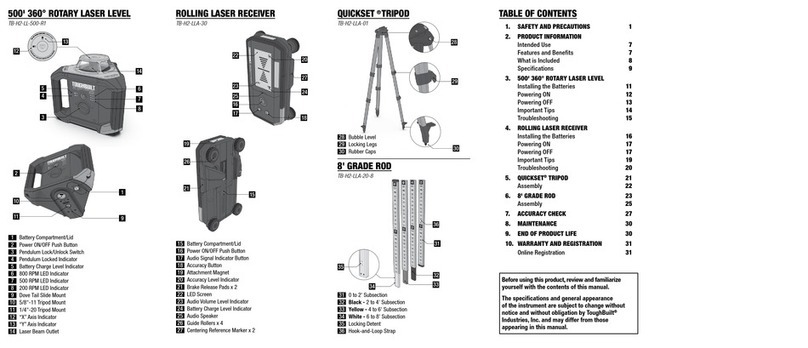
TOUGHBUILT
TOUGHBUILT TB-H2-LL-500-R1 User manual
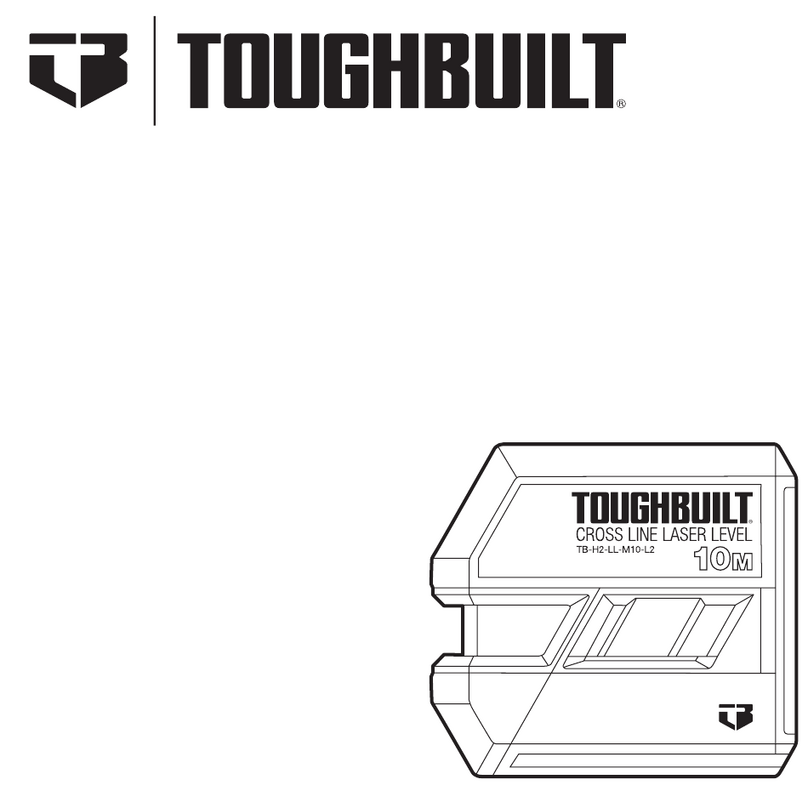
TOUGHBUILT
TOUGHBUILT TB-H2-LL-M10-L2 Assembly instructions
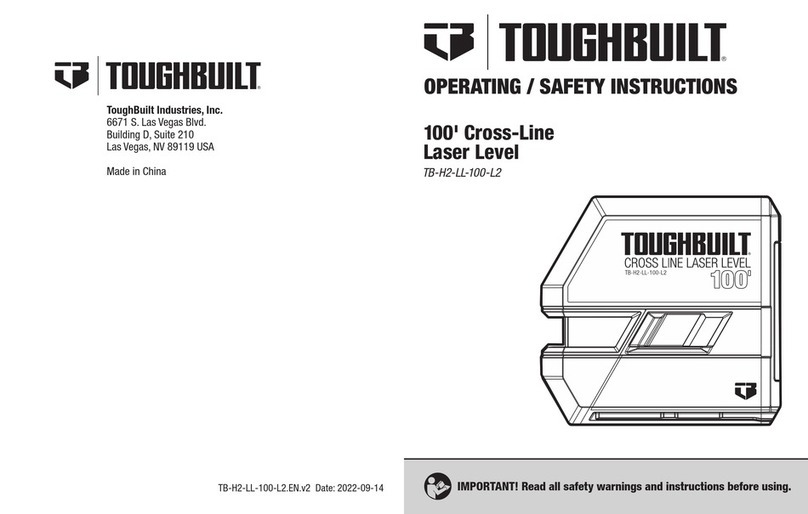
TOUGHBUILT
TOUGHBUILT TB-H2-LL-100-L2 Assembly instructions
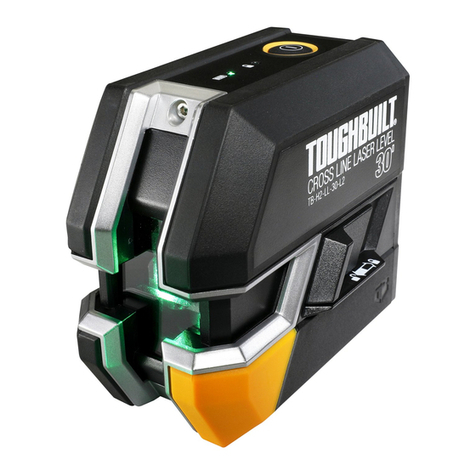
TOUGHBUILT
TOUGHBUILT TB-H2-LL-30-L2 Assembly instructions
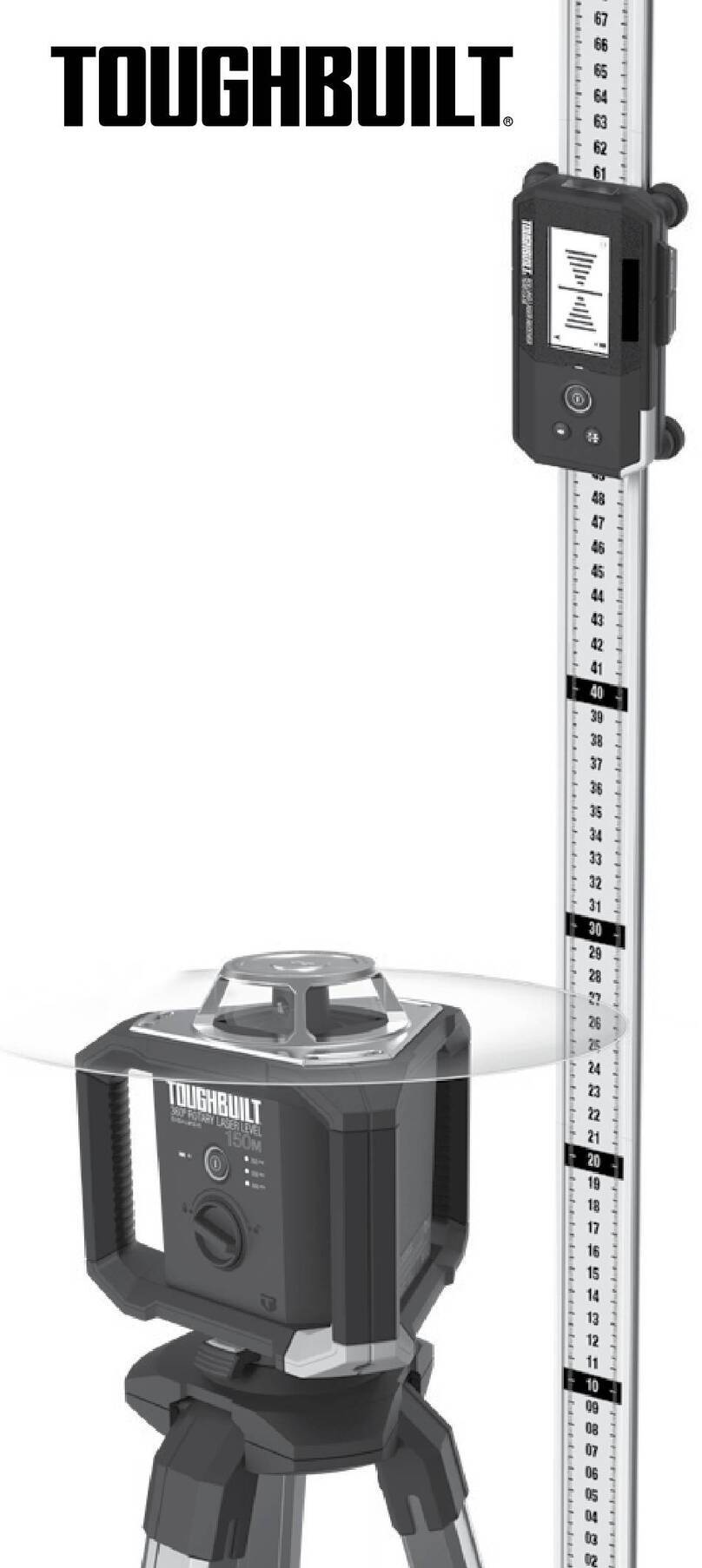
TOUGHBUILT
TOUGHBUILT TB-H2S4-LL-M150-R1 Assembly instructions

TOUGHBUILT
TOUGHBUILT TB-H2-LL-100-L2 Assembly instructions
